
Hackers Beware
.pdfan attacker from obtaining this information in this manner is to use a more secure transport. For example, use secure copy rather than email.
Source Code/Pseudo Code
The following are links to where the various source code/programs can be found: http://www.boson.com/promo/utilities/getpass/getpass_utility.htm
SPHiXe’s C version: http://www.alcrypto.co.uk/cisco/c/ciscocrack.c
Riku Meskanen’s Perl version:
http://www.alcrypto.co.uk/cisco/perl/ios7decrypt.pl
BigDog’s Psion 3/5 OPL version:
http://www.alcrypto.co.uk/cisco/psion/cisco.opl
Major Malfunction’s Palm-Pilot C port:
http://www.alcrypto.co.uk/cisco/pilot/ciscopw_1-0.zip
Boson’s Windows GetPass: http://www.boson.com/download/eula.htm L0pht’s Palm Pilot version: http://www.l0pht.com/~kingpin/cisco.zip
Additional Information
The following are references and links to additional information:
•Cisco IOS Password Encryption Facts http://www.cisco.com/warp/public/701/64.html
•Useful Cisco Password Utilities http://www.alcrypto.co.uk/cisco/
•The PC ASCII Chart http://a1computers.net/pcascii.htm
•Mudge’s explanation of this vulnerability http://www.alcrypto.co.uk/cisco/mudge.txt
•Cisco.txt—Text file from Mudge’s Cisco Type 7 Password Decryptor http://www.l0pht.com/~kingpin/cisco.zip
“Hackers Beware “ New Riders Publishing |
740 |
•The Bitwise XOR Operator http://www.webreference.com/js/tips/991017.html
Man-in-the-Middle Attack Against Key Exchange
This vulnerability enables a hacker to find the session key distributed by a key exchange protocol. This is a man-in-the-middle type of attack. An attacker can exploit this vulnerability without launching a brute force attack on encrypted messages or breaking into any computer. The hacker simply manipulates protocol messages and uses an impersonation tool, such as Hunt.
Exploit Details
•Name: Man-in-the-middle attack against the initiator of OtwayRees Key Exchange Protocol.
•Variants: Man-in-the-middle attack against the two parties of Otway-Rees Key Exchange Protocol.
•Operating System: All operating systems with which the OtwayRees Key Exchange Protocol specification may be implemented because it concerns a specification flaw in the key exchange protocol.
•Protocols/Services: Otway-Rees Key Exchange Protocol.
•Written by: Frédéric Massicotte
Overview
Since the coming of the Internet in the 1980’s and 90’s, information has often been transmitted unscrambled and unprotected over the Internet or various computer networks during remote access, electronic transactions, and so forth. The problem resides in the fact that the Internet is not a proprietary network but, instead, consists of thousands of independent networks. No one has complete control over the route that information takes on the way to a destination. With the Internet’s current design, information security has become a priority. Given the billions of dollars exchanged over the Internet through e-commerce and e-business transactions, and the real threat posed by the interception of secret information, we need tools to make electronic transactions over the Internet secure.
To meet this need, the Internet community has designed new types of communication protocols that function above normal communication and transmission protocols, such as TCP/IP, and so forth. These are known as security or cryptography protocols. SSL (Secure Socket Layer) and SET (Secure Electronic Protocol) are good examples of security protocols currently used in e-commerce to make vender-purchaser transactions
“Hackers Beware “ New Riders Publishing |
741 |
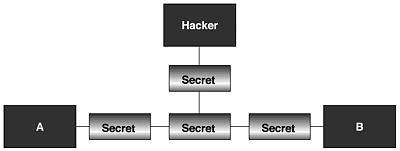
secure. People want assurance that their Internet transactions are secure and that they will not lose important information, such as credit card numbers, passwords, and so forth to hackers. There are several types of cryptography protocols, such as authentication protocols, e-commerce protocols, key distribution protocols, and so on. In this section, we are specifically interested in the vulnerability of key exchange protocols. These protocols are used to distribute a session key to two or more principals to enable them to communicate in a secure fashion by encrypting future information exchanges. Virtual Private Networks (VPNs) are good examples of the use of key exchange protocols. VPNs generally use IKE, a key exchange protocol, for two entities to exchange a secret session key. With this key, they are able to communicate in a secure fashion by encrypting information transmitted in a hostile environment, such as the Internet. Because a hacker does not have the session key to encrypt information, it becomes very difficult for him to obtain secret information by launching a man-in-the-middle attack and monitoring network traffic with a sniffer.
Protocol Description
No one has complete control over the Internet, and it is almost impossible to prevent a hacker from launching a man-in-the-middle attack or retrieving information packets from the network, as Figure 17.26 indicates. One of the solutions to this problem is cryptography and cryptographic algorithms. If each of the principals has the right key, they can make their transaction secure by using cryptographic algorithms, as indicated in Figure 17.27. This key is generally called a session key because it is only used once for a specific session. This key is only good for one session, after which, if the two entities want to communicate again, they must obtain a new key for a new session. However, one problem remains—how to distribute a session key to the two entities in a secure fashion. This is a difficult problem, which may be solved by using a key exchange protocol.
Figure 17.26. Message transmitted in clear text format.
Figure 17.27. Message transmitted in encrypted format.
“Hackers Beware “ New Riders Publishing |
742 |
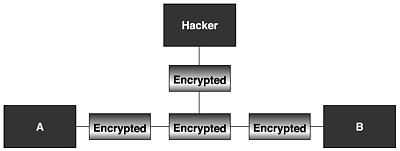
Basic Notions
Before explaining the vulnerabilities of key exchange protocols, we must mention the syntax and symbols used to define security protocol specifications in general. The following symbols are used to specify security protocols:
|
Table 17.1. Symbols used in Security Protocols |
A |
A’s name |
B |
B’s name |
S |
Key Sever |
kas |
symmetric key shared by A and S |
kbs |
symmetric key shared by B and S |
kab |
symmetric session key shared by A and B |
I |
session number |
Na |
random number generated by A |
Nb |
random number generated by B |
The aforementioned symbols are very simple. Upper case letters generally represent computer entities, called principals. We will discuss these in greater depth in the discussion on protocol specifications.
Otway-Rees Key Exchange Protocol Specification
When deploying a key exchange protocol in a wide area network, security people want to ensure that there are no vulnerabilities in protocol implementation and especially specification design to make it difficult for a hacker to compromise the security of information transmitted over the network. When selecting a secure key exchange protocol, we must expect that the protocol key will never be sent unscrambled in a hostile environment outside our control, and that, at the end of the protocol, the entities to receive the session key do actually receive it in a trouble-free manner, without hackers intercepting it. However, as we will see, without decrypting any message or attacking or breaking into any computer, hackers may manipulate information to obtain the session key without either of the entities detecting the ruse. To illustrate this problem, we are going to study the Otway-Rees Key Exchange Protocol. The complete
“Hackers Beware “ New Riders Publishing |
743 |
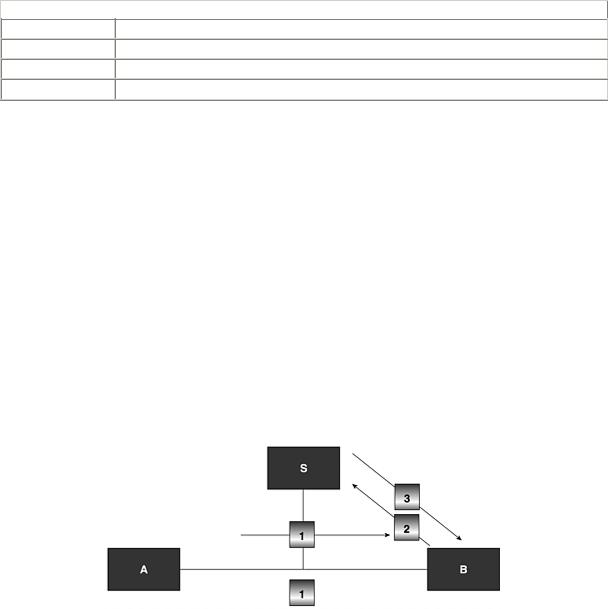
protocol specification can be found in Bruce Scheier’s book, Applied Cryptography.
The Otway-Rees Protocol makes it possible to distribute a session key kab, created by the trusted server S, to two principals A and B. This key encrypts the information transmitted between these two principals. Sharing this key and the cryptographic algorithms creates a VPN-type communication tunnel between the two principals.
In addition, this protocol authenticates the principals to ensure the integrity of messages and that the key has been correctly distributed to the correct principals. This prevents the key from falling into the wrong hands, such as those of a hacker who is hijacking a session or conducting a man-in-the-middle attack. The Otway-Rees Key Exchange Protocol is specified as follows:
Table 17.2. Otway-Rees Key Exchange Protocol
Message 1 A ‡ B: I,A,B { Na, I, A, B }kas
Message 2 B ‡ S: I,A,B { Na, I, A, B }kas, { Nb, I , A, B }kbs
Message 3 S ‡ B: I, { Na, kab}kas, { Nb, kab}kbs
Message 4 B ‡ A: I, { Na, kab }kas
Thus, as we can see, at the end of the protocol, the key kab is received by A and B, which are now ready to exchange confidential or secret information.
The message in the form { m }k symbolizes that message m has been encrypted with k using a symmetrical cryptographic algorithm. Before starting the protocol, each of the principals has certain initial knowledge. Keys kas and kbs are permanent keys given to A and B, respectively, as personal keys. They must share these with the server to communicate with it. With these permanent keys, the principals are able to obtain a session key from the server.
The cryptography protocol may be described in more detailed fashion as illustrated in Figure 17.28.
Figure 17.28. Otway-Rees Key Exchange Protocol.
“Hackers Beware “ New Riders Publishing |
744 |
A sends B the protocol session number, its identity, the identity of the principal with which it wants to communicate, and a message encrypted with the key kas.
B receives A’s message and adds its own message encrypted with the key kbs before sending it to the trusted server S.
S receives the message and is able to retrieve the session number, the random number from A, Na using its shared key kas, the random number from B, Nb with the other shared key kbs, and generates the session key kab. With this information, S is able to generate message 3 and sends it to
B.
The principal in question receives message 3, removes the last encrypted part with its shared key, decrypts this sub-message with its key kbs, retrieves the session key kab, and sends the remaining part of the message to A. In this way, A is also able to retrieve the session key kab, based on the last part of message 4 by using its shared key kas, and the two principals are able to start communicating.
In addition to using session numbers to ensure message authentication and integrity, this key exchange protocol uses random numbers, such as stamps to identify sessions. The random number Na can only be known by A and the trusted server S, because it is always encrypted by the key kas when it is transmitted over the network. Therefore, when A receives the key kab at the end of the protocol, it can be sure that the session key is genuine and that it was, in fact, generated by the server, by verifying if the random number received in the last message is the same one generated in the first message. In this protocol, we can use the same logic with respect to the random number Nb for principal B.
In addition, we can see that a session key is always encrypted when it is transmitted between principals over a computer network. Indeed, the session key is always encrypted by the keys kas and kbs, and the only parties with these keys are the principals A, B, and S. Therefore, a hacker cannot retrieve the session key in any way if the cryptographic algorithm is perfect and there are no security vulnerabilities in the protocol implementation.
If a hacker impersonates principal A to principal B and impersonates B without A realizing it by launching a classic man-in-the-middle attack with Hunt-type software or controlling a router through which the information is transmitted, he will be able to deceive the principals about his identify. However, he will not be able to retrieve the key, as shown in Figure 17.29.
Figure 17.29. Simple man-in-the-middle attack against Otway-Rees Key Exchange Protocol.
“Hackers Beware “ New Riders Publishing |
745 |
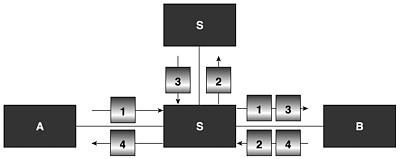
How the Exploit Works
Most of the time, hackers exploit security vulnerabilities in software implementation or find insecure systems to attack. Most of the time, even the most sophisticated systems maintained by the best security technicians may have security vulnerabilities. Given their current level of complexity, it is almost impossible for programs to be completely free of vulnerabilities or bugs. This is what we must expect with security software or protocols. However, most security vulnerabilities discovered in recent years and posted on Internet sites, such as www.securityfocus.com and www.ntbugtraq.com, or on hacker sites are almost exclusively implementation vulnerabilities, such as overflow buffers, program errors, and so forth.
We often forget that some vulnerabilities may only be discernable at the specification and design level. Even today, it may be difficult to develop cryptography protocols without vulnerabilities. Otway-Rees Key Exchange Protocol does, in fact, have a specification vulnerability that enables a hacker to steal the session key.
In particular, if a hacker wants to steal the session key, he must be able to determine the content of messages 3 and 4. He may also attack the server or one of the principals to retrieve the permanent keys or attempt a brute force attack on the encrypted messages that he retrieved from the computer network. However, this may be more complicated than exploiting the protocol vulnerability. Indeed, the hacker may retrieve the key by simply manipulating information. He has to impersonate principal B with Hunt-type software. When A is ready to start a protocol session, the hacker launches the attack as follows:
|
Table 17.3. Attack Against the Initiator of Otway-Rees Key Exchange Protocol |
|
Message 1 |
|
A ‡ I(B): I,A,B { Na, I, A, B }kas |
Message 4 |
|
I(B) ‡ A: I, { Nb, I, A, B }kas |
When A wants to start a session with B, hacker I(B) impersonates B with Hunt-type software. By placing a sniffer at the right place on the computer network, he retrieves the first message, the session number, and the encrypted part of the message, concatenates all the components, and
“Hackers Beware “ New Riders Publishing |
746 |
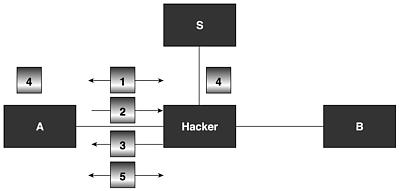
sends the result to principal A. This party retrieves the message, verifies the session number, decrypts the encrypted message with its permanent key, verifies if it has correctly received the random number that it sent in message 1, and concludes that the second part of the decrypted message is the session key. Therefore, the session key for this session is the message I,A,B. Because this message is sent unscrambled over the computer network, the hacker may intercept it and, thereby, steal the secret key. Indeed, principal A does not know the session key before receiving message 4. Therefore, A will accept any bit string which is the same length as the session key and encrypted with the right random number and the key kas.
To carry out this attack, a hacker only needs to know the protocol and how it behaves. He does not need to carry out Steps 2 and 3 of the protocol. In fact, there is no way for A to know that these two steps in the protocol have not been carried out.
Thus, the hacker does not need to know the permanent keys and does not have to encrypt or decrypt any information at all. By simply manipulating information, he can find the protocol session key and start exchanging secret information with principal A without anyone suspecting that A is in the process of exchanging secret information with a hacker.
Figure 17.30 shows how this type of the attack may be carried out on a network.
Figure 17.30. Attack against the initiator of the Otway-Rees Key Exchange Protocol.
When A wants to establish a connection with B for this protocol, the hacker manages to gain control over an entity through which information is transmitted and uses Hunt-type software to impersonate B. When the connection is established, A starts a protocol session and sends the hacker impersonating B the message: I,A,B { Na, I, A, B }kas.
The hacker receives the message, removes A,B, generates the message: I, { Na, I, A, B }kas, and sends it to A. A retrieves the session key I,A,B
“Hackers Beware “ New Riders Publishing |
747 |

and the hacker does the same with the information retrieved from the network. Principal A sends encrypted messages with the session key. The hacker now has complete control over the connection, as if it had never been encrypted with a session key. To him, the information on the network appears to be unscrambled.
For more information on session hijacking, see Chapter 5, " Session Hijacking."
Variants Description
Otway-Rees has several variants of this vulnerability. There are, in fact, several ways of actually carrying out this attack on a real computer network. In addition, the hacker has several options concerning which principal’s identity he may assume to steal the session key and compromise the security of information transfer. In fact, even if the hacker does not control the connection between A and B, he will nevertheless be able to carry out an attack if he is able to monitor traffic between A and B and control traffic between B and the server. The variants of the attack are shown in Table 17.4:
Table 17.4. Attack Against the Two Parties of Otway-Rees Key Exchange Protocol
Message 1 A ‡ B: I,A,B { Na, I, A, B }kas
Message 2 B ‡ I(S): I,A,B { Na, I, A, B }kas,{ Nb, I , A, B }kbs
Message 3 I(S) ‡ B: I, { Na, I, A, B }kas,{ Nb, I , A, B }kbs
Message 4 B ‡ A: I, { Na, I,A,B }kas
In this attack, the hacker lets principals A and B establish a connection and exchange the first message in the protocol. Then B must establish a connection with the server. At this point, the hacker, who has managed to gain control over the information moving between B and S, uses Hunttype impersonation software and, by impersonating the server, establishes a connection with principal B, who sends him message 2. After receiving it, the hacker returns the same message after removing the message A,B. Therefore, based on the protocol, principal B takes the second encrypted message and finds the session key I,A,B, as A did in the first attack. Then, according to the protocol specification, B sends message 4 to principal A, which is, in fact, message 3 without the part encrypted with B’s permanent key (which was removed before being sent). At this point, B just follows the protocol specification and has no way of determining whether the session key that it is going to transmit to principal A is in fact the right key generated by the server. A then retrieves the message and also finds the key I,A,B, like the key generated by the server. A and B can then send each other information encrypted with this new session key. However, if the hacker is able to sniff the information moving between A and B, he will be able to decrypt the information in its entirety without either principal realizing it.
“Hackers Beware “ New Riders Publishing |
748 |
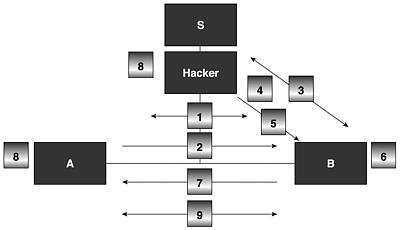
Figure 17.31 shows one of the methods that a hacker may use on an actual computer network.
Figure 17.31. Attack against the two parties of the Otway-Rees Key Exchange Protocol.
Principal A establishes a connection with B for this protocol.
Principal A sends the message: I,A,B, { Na, I, A, B }kas to B.
When B wants to establish the connection with the server, the hacker manages to gain control over an entity through which information is being transmitted and uses Hunt-type software to assume the identity of the server.
Principal B sends the message I,A,B, { Na, I ,A, B}kas, { Nb , I , A, B}kbs to the server impersonated by the hacker.
The hacker returns almost the same message, but without the submessage A,B.
Principal B finds the session key, which is the same as the message I,A,B.
Principal B sends the message I, { Na, I , A, B}kas to principal A to end the protocol.
The hacker finds the session key I,A,B and he easily finds the session key with the message that B sent him.
A and B start exchanging secret encrypted information with the session key. Using his sniffer placed between the two principals, the hacker is able to decrypt all the information as if it were being transmitted on the network unscrambled.
“Hackers Beware “ New Riders Publishing |
749 |
